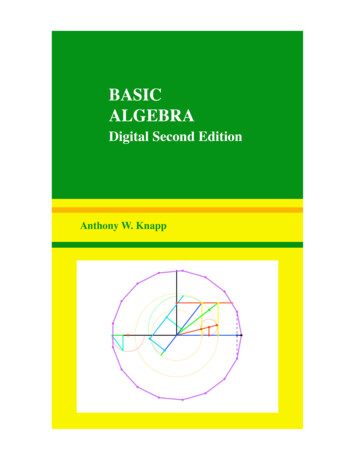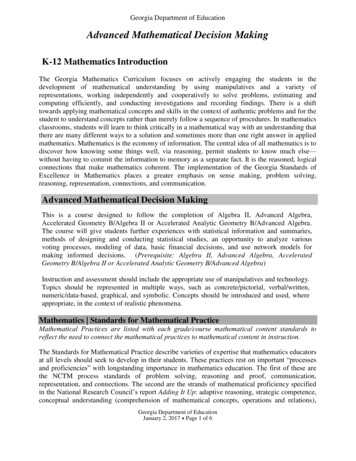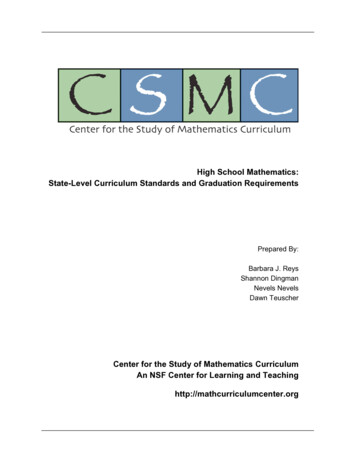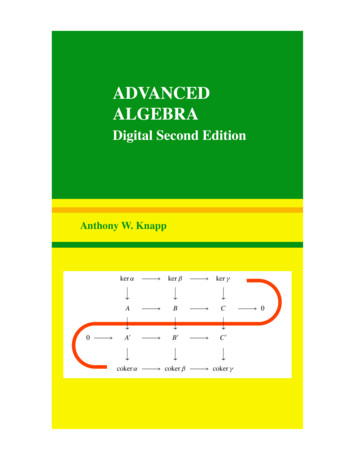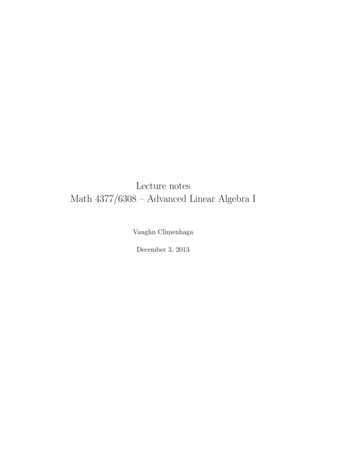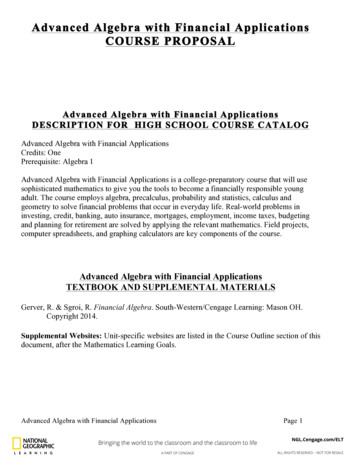
Transcription
Advanced Algebra with Financial ApplicationsCOURSE PROPOSALAdvanced Algebra with Financial ApplicationsDESCRIPTION FOR HIGH SCHOOL COURSE CATALOGAdvanced Algebra with Financial ApplicationsCredits: OnePrerequisite: Algebra 1Advanced Algebra with Financial Applications is a college-preparatory course that will usesophisticated mathematics to give you the tools to become a financially responsible youngadult. The course employs algebra, precalculus, probability and statistics, calculus andgeometry to solve financial problems that occur in everyday life. Real-world problems ininvesting, credit, banking, auto insurance, mortgages, employment, income taxes, budgetingand planning for retirement are solved by applying the relevant mathematics. Field projects,computer spreadsheets, and graphing calculators are key components of the course.Advanced Algebra with Financial ApplicationsTEXTBOOK AND SUPPLEMENTAL MATERIALSGerver, R. & Sgroi, R. Financial Algebra. South-Western/Cengage Learning: Mason OH.Copyright 2014.Supplemental Websites: Unit-specific websites are listed in the Course Outline section of thisdocument, after the Mathematics Learning Goals.Advanced Algebra with Financial ApplicationsPage 1
Advanced Algebra with Financial ApplicationsBRIEF COURSE DESCRIPTIONAdvanced Algebra with Financial Applications is a mathematical modeling course that isalgebra-based, applications-oriented, and technology-dependent. The course addresses collegepreparatory mathematics topics from Advanced Algebra, Statistics, Probability, Precalculus,and Calculus under seven financial umbrellas: Banking, Investing, Credit, Employment andIncome Taxes, Automobile Ownership, Independent Living, and Retirement Planning andHousehold Budgeting. The course allows students to experience the interrelatedness ofmathematical topics, find patterns, make conjectures, and extrapolate from known situations tounknown situations.The mathematics topics contained in this course are introduced,developed, and applied in an as-needed format in the financial settings covered. Students areencouraged to use a variety of problem-solving skills and strategies in real-world contexts, andto question outcomes using mathematical analysis and data to support their findings. Thecourse offers students multiple opportunities to use, construct, question, model, and interpretfinancial situations through symbolic algebraic representations, graphical representations,geometric representations, and verbal representations. It provides students a motivating, youngadult centered financial context for understanding and applying the mathematics they areguaranteed to use in the future, and is thusly aligned with the recommendations of theCommon Core State Standards, as stated in this excerpt:“.all students should be strongly encouraged to take math in all years of high school. .Anarray of challenging options will keep math relevant for students, and give them a new set oftools for their futures ” From the Common Core State StandardsAdvanced Algebra with Financial ApplicationsPage 2
Advanced Algebra with Financial ApplicationsCOURSE PURPOSEAdvanced Algebra with Financial Applications offers 11th and 12th grade students anopportunity to view the world of finance through a mathematical lens. The topics weredeveloped using the Common Core State Standards in Mathematics, the CaliforniaMathematics Standards, and the NCTM Curriculum and Evaluation Standards. Themathematical formulas, functions, and pictorial representations used assist students in makingsense of the financial world around them and equip them with the ability to make soundfinancial decisions.The overarching purpose of the course is to develop the type of mathematically proficientstudents addressed in this excerpt from the Common Core State Standards for Mathematics.Mathematically proficient students can apply the mathematics they know to solve problemsarising in everyday life, society, and the workplace. Mathematically proficient students whocan apply what they know are comfortable making assumptions and approximations to simplifya complicated situation, realizing that these may need revision later. They are able to identifyimportant quantities in a practical situation and map their relationships using such tools asdiagrams, two-way tables, graphs, flowcharts and formulas. They can analyze thoserelationships mathematically to draw conclusions. They routinely interpret their mathematicalresults in the context of the situation and reflect on whether the results make sense, possiblyimproving the model if it has not served its purpose.Advanced Algebra with Financial Applications builds strength in reasoning and number sense,because the real-world applications demand that solutions make sense. Through contextualproblem solving and the mathematical modeling of real situations, the course gives the studentsthe motivation to persevere through routine and non-routine problems, and as a result, developstrength and confidence in their mathematics ability.Advanced Algebra with Financial ApplicationsPage 3
Advanced Algebra with Financial ApplicationsCOURSE OUTLINEUnit 1: Banking ServicesIn this unit, students use exponential functions to compute compound interest and compare it tosimple interest. They derive formulas and use iteration to compute compound interest. Theyapply their findings to short-term, long-term, single deposit and periodic deposit accounts. Theproblems, activities and projects inherent in studying banking are a natural forum for all eightCCSS Mathematical Practice standards, but this unit highlights MP1, MP4, MP5, MP6, andMP8.Common Core State Standards for Mathematical Content that are AddressedA-CED4A-SSE1a, A-SSE1b, A-SSE3F-IF4, F-IF8bF-BF1aN-RN1, N-RN2Mathematics Topics Derivation of the compound interest formula Exponential functions Computations based on iterative processes Limits of polynomial functions, rational functions, and sequences Natural logarithm as the inverse of the exponential function Exponential growth and decay Solving exponential equations Using inductive reasoningMathematics Learning Goals Cross-Referenced with Textbook and Key Assignments§ Students will use the simple interest formula I PRT and using inverseoperations to solve for missing variables in interest problems. Financial Algebrasection 3-3 teaches students how to compute I (interest), P (principal), R (rate), and T(time). They solve for one of the variables in terms of the others in numeric and literalequations. They use number sense to confirm the reasonableness of their answers.§ Students will use iteration to show how compounding pays “interest on yourinterest.” Financial Algebra section 3-4 shows iterative processes that underscore themeaning of compound interest. Students use calendars to document the iteration and seewhere interest is added and then used as principle to compute subsequent interest. KeyAssignment 1.1 requires students to guess future values based on the intuitive notion ofcompound interest.Advanced Algebra with Financial ApplicationsPage 4
§ § § § § § § § rnntStudents will derive the compound interest formula B (1 ) by using patternsand inductive reasoning. Financial Algebra section 3-4 algebraically derives theformula for quarterly compounding, and then uses inductive reasoning to extend theformula into compounding over any period of time. Key Assignment 1.2 involveslooking for patterns to make inductive inferences about a generalized compoundinterest formula.Students will compute compound interest with and without the formula. FinancialAlgebra sections 3-3 through 3-6 illustrates compounding with and without theformulas, and shows how daily compounding is adjusted for deposits and withdrawals.Students will apply and interpret the limit notation Lim f ( x ) b . Financialx aAlgebra section 3-6 investigates limits since they will be used in the concept ofcontinuous compounding. Students will compute limits of rational functions and otherexpressions. Key Assignment 1.3 will highlight a limit that is central to the continuouscompounding formula.Students will model an infinite series and finding a finite sum for an infinite serieswith common ratio ½. Financial Algebra section 3-6 features the classic problemwhere someone walks across a room by first walking half the room, then half of theremaining half, etc. Students realize that they do actually cover the entire room, andthat the sum is 1.Students will compute limits of rational functions as x . . Financial Algebrasection 3-6 has students examining numerators and denominators to intuitivelydetermine function values as variable quantities approach infinity.Students will approximate the natural base e by examining the sequence 1 x for increasing values of x. Financial Algebra section 3-6 discuss the 1 x “battle” between the decreasing base and the increasing exponent, which ends up withthe natural base e. Key Assignment 1.3 uses calculator tables to make inferences abouta rational function’s pattern as a variable approaches infinity.Students will inductively derive the natural base e using limits. Financial Algebrasection 3-6 has an activity that displays the pattern leading to the natural base e. This isa component of Key Assignment 1.3.Students will apply the natural base e in the continuous compounding formulaB Pert . Financial Algebra section 3-6 uses the formula for continuous§ § compounding to model the effect as compared to other types of compounding.bStudents will be able to identify y ax as exponential decay when x 1.Financial Algebra section 5-6 models exponential decay by looking at depreciation ofan automobile, which offers a contrast to growth via compound interest.bStudents will be able to identify y ax as exponential growth when x 1.Financial Algebra section 8-5 uses exponential growth to model rent increases. Theconstant percent of annual increase is modeled by an exponential function.Advanced Algebra with Financial ApplicationsPage 5
§ § bStudents will graph exponential functions of the type y ax . Financial Algebrasection 5-6 has students using exponential regression on the calculator to modelexponential functions. These functions are used to model automobile prices over theyears.Students will analyze rational function behavior and limits of the formax n b where n m, n m, and n m. Financial Algebra section 3-6 hasLim mx cx d§ students examining numerators and denominators to compare their growth. The relativesize of the numerators and denominators, and the powers of the highest exponents leadstudents to find rules for rational function limits.Students will compute Annual Percentage Yield (APY) where APY 1 § nr 1 , given the Annual Percentage Rate (APR). Financial Algebran section 3-5 derives formulas used to compute and compare APY and APR.Students will use the compound interest formula to derive the present value of asingle deposit investment formulaP § r 1 n ntFinancial Algebra section 3-8 derives the present value formula in the context ofcompound interest.Students will use the compound interest formula to derive the present value of aperiodic deposit investment formula§ B r B n P nt r 1 1 n Financial Algebra section 3-8 adjusts the present value formula to include periodicdeposits.Students will use the future value of a periodic deposit investment formula r nt P 1 1 n B r n § Financial Algebra section 3-7 uses the formulas for the future value of a single-depositinvestment and for a periodic deposit. Key Assignment 1.4 applies this formula tocollege costs, which is something many of the students are concerned with. They alsohave to imagine they are young parents and have to plan to save for college costs in thefuture, which they must compute using regression.Students will adapt the algebra from banking formulas for input into aspreadsheet. Financial Algebra sections 3-4 and 3-7 require students to adapt thestructure of algebraic thinking to the language understood by the spreadsheet program.Advanced Algebra with Financial ApplicationsPage 6
This requires intense attention to precision since any deviation from the correct syntaxwill prevent the spreadsheet from computing correctly.Internet Resources for Supporting Learning in the Banking UnitFederal Deposit Insurance Corporation www.fdic.gov. Students can explore how they canmaximize accounts that are covered by have different types of accounts in one bank.Loan Payment Calculator www.bankrate.com. Students can easily compare many differenttypes of loans by changing term, rate, and principle, and they can compare the softwareanswers to answer they get using algebraic formulas.Unit 2: InvestingStudents are introduced to basic business organization terminology in order to read, interpret,chart and algebraically model stock ownership and transaction data. Statistical analysis plays avery important role in the modeling of a business. Using linear, quadratic, and regressionequations in that process assists students in getting a complete picture of supply, demand,expense, revenue, and profit as they model the production of a new product. The problems,activities, and key assignments in this Investing Unit offer students opportunities to learn,explore, and use the CCSS Mathematical Practices MP1, MP2, MP3,MP4, MP5.Common Core State Standards for Mathematical Content that are AddressedA-CED1, A-CED2, A-CED3, A-CED4A-REI2, A-REI3, A-REI4b, A-REI6, A-REI7, A-REI10, A-REI11,A-REI12A-SSE1F-IE4F-IF1, F-IF4, F-IF5, F-IF7a, F-IF8, S-ID6N-Q1, N-Q2, N-Q3S-ID8, S-ID9Mathematics Topics Algebraic ratios and proportions Algebraic representations of percent increase and decrease Pictorial representations of data Scatterplots Operations with functions Function domains Function evaluation Linear and quadratic functions to model situationsAdvanced Algebra with Financial ApplicationsPage 7
Rational functionsSystems of equations (linear/linear and linear/quadratic)Systems of inequalitiesRegression equationsExtrapolation and interpolationPearson Product-Moment Correlation CoefficientAxis of symmetry, roots, intercepts and concavity of parabolasQuadratic formulaAbsolute and relative extremaExplanatory, response, and lurking variablesCausation vs. correlation for bivariate dataTransitive Property of DependenceZero Net DifferenceMathematical Learning Goals Cross-Referenced with Textbook and Key Assignments§ § § Students will construct, use, and interpret algebraic ratios and proportions.Financial Algebra section 1-1 examines ratios as used to model business partnershipshares. Here, given a set of n compound ratios and a total T, students write and solveequations in terms of x and T where the variable coefficients are the ratios anddetermine the amount associated with each ratio. Financial Algebra sections 1-2, 1-6,1-8, and 1-9 explore the use of ratio and proportions in the context of stock markettransactions, stock prices, and stock dividends. Financial Algebra sections 2-2, 2-5, and2-6 offer students opportunities to model and interpret ratios and proportions within thecontext of a new business venture. In all of these sections, students use, interpret andevaluate rational expressions, algebraic fractions, ratios, and proportionsStudents will determine, use, and interpret percent increase/decrease of monetaryamounts. Financial Algebra section 1-2 has students determine percent increase anddecrease in the context of stock prices. Students then translate what they have learnedto writing algebraic and spreadsheet formulas for percent net change.Students will constructing and interpret pictorial representations of data.Financial Algebra sections 1-3 and 1-4 teaches students how to chart and interpretstock market trends pictorially and graphically. Financial Algebra Chapter 2 focuses onthe mathematical modeling of a business. Here, students use regression analysis,functions, and graphs to model how expense, revenue and profit functions worktogether to assist in setting the per unit price that will result in the maximum profit. KeyAssignment 2.1 applies these skills in the context of charting corporate stocks usingOHLC and Candlestick charts. Students also chart multiple time intervals of simplemoving averages for closing prices in order to analyze crossover graphs. Based uponthe interpretations of these graphs, students are asked to identify and explain stocktrend reversal points.Advanced Algebra with Financial ApplicationsPage 8
§ § § § !§ § § § Given a set of n data points, p1, p2 , p3 , ., pn "1, pn , students will calculate andinterpret d-day simple moving averages by applying the Arithmetic AverageFormula and the Subtraction/Addition Method. Financial Algebra section 1-4introduces students to the concept of data smoothing through the use of simple moving!averages. Students calculate,chart, and interpret the simple moving average crossovergraphs to make informed decisions about stock trend reversals. Key Assignment 2.1uses real world data collected by students to reinforce the smoothing effects that simplemoving averages have on that data.In any a-for-b stock split, where P represent the pre-split price per share, studentsbwill calculate the post-split price per share using" P Financial Algebra sectiona1-8 employs ratio and proportions to create pre- and post-split market price functions.In any a-for-b stock split, where D represent the pre-split number of shares,astudents will calculate the post-split number! of shares using " D FinancialbAlgebra section 1-8 employs ratios and proportions to create pre- and post-splitoutstanding shares functions.Students will calculate the stock yield percentage using the formula!AYield " 100 , where A represents the annual dividend per share and CCrepresents the current price per share. Financial Algebra section 1-9 defines yieldas a ratio and offers students opportunities to calculate monetary yield amounts as wellas write algebraic expressions that can be used to create yield formulas.Students will construct and interpret scatterplots . Financial Algebra sections 2-1and 2-2 introduce students to scatter plots as an important part of regression analysis.Students will identify form, direction, and strength from a scatterplot. Section 2-8 hasstudents construct and interpret scatterplots as part of the business model fordetermining optimal unit prices. Key Assignment 2.2 uses focus group data in the form(p,q) where p is a potential price of a new product and q is the quantity of the productthat the focus group members would purchase if set at that price. Students construct andanalyze a scatterplot of these ordered pairs.Students will delineate causation vs. correlation for bivariate data. FinancialAlgebra sections 2-1 and 2-2 introduce students to the concepts of causal andcorrelational relationships in the context of small business ventures.Students will identify explanatory, response, and lurking variables. FinancialAlgebra section 2-1 sets the stage for regression by examining business trend analysisvariables.Students will find, interpret, and graph linear regression equations and determinethe correlation coefficient. Financial Algebra sections 2-2 and 2-8 utilize linearregression analysis to model business situations. Students determine domains for whichprediction using a regression line is considered extrapolating or interpolating. Studentsfind and interpret the Pearson Product-Moment Coefficient of Correlation and use thatvalue to make inferences about the line of best fit in a business model. Key Assignment2.1 offers students an opportunity to use regression analysis in making stock pricepredictions using the closing price data they have collected over a 15 trading dayAdvanced Algebra with Financial ApplicationsPage 9
§ § § § § § § § period. Key Assignment 2.2 has students determine a linear demand regressionequation using focus group data in the form (p,q) where p is a potential price of a newproduct and q is the quantity of the product that the focus group members wouldpurchase if set at that price. They must find the correlation coefficient and interpret thevalue as it pertains to the focus group data and the demand regression equation.Students will create and evaluate functions, and use them to model situations.Financial Algebra Chapters 1 and 2 have students creating, using, and graphingfunctions in the contexts of the stock market and business entrepreneurship.Students will translate verbal situations into algebraic linear functions. FinancialAlgebra sections 1-1, 1-2, 1-6, 1-7, 1-8, 1-9, and 1-10 offer students opportunities tomodel stock market situations using linear functions. Students also use linear functionsin section 2-3 to model product demand and in section 2-4 to model fixed and variableexpenses. Key Assignment 2.2 asks students to model expense and demand usinglinear functions.Students will translate verbal situations into quadratic functions. FinancialAlgebra sections 2-5 and 2-6 explore the use of quadratic functions to model revenueand profit. Key Assignment 2.2 has students model revenue and profit using quadraticfunctions.Students will translate verbal situations into linear and quadratic inequalities.Financial Algebra sections 2-6 through 2-8 use linear and quadratic inequalities tocontextualize the relationships between and among expense, revenue, and profitfunctions.Students will translate verbal situations into linear and quadratic inequalities.Financial Algebra sections 2-6 through 2-8 use linear and quadratic inequalities tocontextualize the relationships between and among expense, revenue, and profitfunctions.Students will solve linear systems of equations and inequalities such as:and identify points ofintersection and domains in the context of the problem situation. Financial Algebrasection 2-4 explores the use of linear systems to model revenue and expense situations.Students identify domains for which f(x) g(x), f(x) g(x), and f(x) g(x). KeyAssignment 2.2 asks students to contextualize the domains of intersecting functions f(x)and g(x) where f(x) g(x), f(x) g(x), and f(x) g(x).Students will solve linear-quadratic systems of equations and inequalities, andinterpret the roots, intersection points, relative extrema, absolute extrema, anddomains in the context of the problem situation. Financial Algebra sections 2-6Advanced Algebra with Financial ApplicationsPage 10
§ § § through 2-8 models business contexts using linear-quadratic systems of equations. KeyAssignment 2.2 uses linear-quadratic systems of equalities and inequalities tocontextualize the modeling of product price setting for optimal profit.Students will use the transitive property of dependence. Financial Algebra section2-8 sets the stage for the linear/quadratic business model by examining the concept ofvariable dependence (if x depends on y, and y depends on z, it follows that x dependson z.)Students will determine the zero net difference. Financial Algebra section 2-6defines zero net difference functions as a function that is the difference of a quadraticrevenue function and a linear expense function. The zero net difference points are thepoints of intersection of the linear/quadratic system.Students will write algebraic formulas for use in spreadsheets. Financial Algebrasections 1-2, 1-4, 1-8, 1-9, 2-2, and 2-6 ask students to create stock market and businessmodel linear and quadratic formulas for use in spreadsheets.Internet Resources for Supporting Learning in the Investing UnitThe New York Stock Exchange www.nyse.nyx.com This site offers students and educatorsdetailed and current information about the New York Stock ExchangeYahoo! Finance finance.yahoo.com Students can access historical and daily tradinginformation on corporate stocks.The Stock Market Game www.stockmarketgame.org This website offers students, teachers,and parents virtual investment opportunities in an educational setting.Thirteen edonline “Could You Start A ns/fe start/index.htmlTeachers and students explore the financial requirements needed to start a business.Investopedia www.investopedia.com This is a comprehensive investment website for studentsand adults. It covers topics on investment, the stock markets, personal finance, trading, andmuch more. It is an excellent source of investing information for many of the student projects.Unit 3: Employment and Income TaxesMany Internal Revenue Service and Social Security Administration regulations can be modeledby using linear and polygonal functions that have different slopes over different domains. Lineby-line instructions for IRS forms can also be algebraically symbolized. The problems,activities and projects inherent in studying employment and income taxes are a natural forumfor all eight CCSS Mathematical Practice standards, but this unit highlights MP1, MP4, MP5,MP6, and MP7.Advanced Algebra with Financial ApplicationsPage 11
Common Core State Standards for Mathematical Content that are AddressedA-CED1, A-CED2, A-CED3, A-CED4A-REI3A-SSE1F-BF1F-IF1, F-IF2, F-IF4, F-IF7b, F-IF8F-LE1Mathematics Topics Point-slope form of linear equations Jump discontinuities Continuous functions with cusps Slope Compound inequality notation Piecewise functions Interval notation Percent increase and decrease Data analysis Algebraic modelingMathematics Learning Goals§ Students will determine and interpret domains of piecewise functions of the formsFinancial Algebra sections 7-1, 7-2, 5-1, 63, 9-3 and 10-2 require students to model real-life situations using piecewise functions.Key Assignment 3.2 involves modeling the FICA tax function, and interpreting its cuspand its slopes over different domains.Advanced Algebra with Financial ApplicationsPage 12
§ Students will graph piecewise functions with cusps such as§ Financial Algebra section 6-5 and Key Assignment 3.2require students to interpret the slope as a rate, and use the units of the rate to explainwhat the graph shows.§ Students will compute measures of central tendency and rational functions such asa ( x) § § § 40r 1.5tr . Financial Algebra section 6-4 analyzes pension computations byt rexpressing the mean as a rational function used to compute average salaries thatdetermine pension amounts.Students will use geometric sequences such as an xr n with common ratio r.Financial Algebra section 6-2 features the “penny doubled every day” problem to showthe power of exponents. A pay scale that defies mathematical intuition is designed toshow exponential growth with common ratio 2.Students will express percent increases and decreases as rational functions.Financial Algebra section 1-6 highlights classic percent increase and percent decreaseusing capital gains, and the students create rational functions to represent gains andlosses.Students will use the point-slope form y y1 m( x x1 )and convert it to slopeintercept form y mx b . Financial Algebra section 7-1 models the tax worksheet andderives the instructions on the tax worksheet using the piecewise function they create tomodel the tax schedules. Key Assignment 3.1 highlights the conversion of one form tothe other, and shows how slope intercept form is used by the IRS on the tax worksheet.The ease of computation inherent in the slope-intercept form sacrifices informationportrayed in the point-slope form about income thresholds and tax brackets.Advanced Algebra with Financial ApplicationsPage 13
§ § § § § § Students will graph continuous polygonal functions with multiple slopes and cuspssuch as:Financial Algebrasections 7-1 and 7-2 uses continuous polygonal functions to model tax schedules. Thecusp represents the points at which the tax brackets change. Key Assignment 3.2features continuous functions with cusps derived from the FICA tax function. Studentsinterpret the horizontal component, and its slope as a rate.Students will translate verbal expressions into literal rational, exponential, andlinear equations. Financial Algebra sections 6-1 through 6-5 and 7-1 through 7-5, andin fact, all sections of the text, require students to frequently use equations to representverbal situations. This is a necessary cornerstone of any math modeling course.Students will express domains using compound inequality notation of the formt t1 and t t2 . Students will express domains using compound inequalitynotation of the form t t1 and t t2 , interval notation of the form t1 x t 2 ,and tax schedule notation of the form “over t1 but not over t 2 .” Financial Algebrasections 7-1 and 7-2 use compound inequalities and interval notation to model thebrackets on the income tax schedule. The tax brackets are defined by inequalities andstudents need to differentiate between “less than” and “less than or equal to” by readingcarefully.Students will model a tax bracket, given a compound inequality statement, andmodel a tax bracket to determine the tax using a linear equation of the form.y a p( x t1 ) where y is the tax, a is the base tax, p is the tax percentageexpressed as a decimal, (t1 is the lower boundary of the domain, and x is thetaxable income). Financial Algebra section 7-2 has students analyzing the IRSverbiage and compound inequalities, and translating from one to the other. FinancialAlgebra section 7-2 has the students computing taxes form the piecewise function, andfrom the linear function in slope-intercept form used on the IRS tax worksheet.Students will interpret jump discontinuities. Financial Algebra sections 6-5 and 7-2use continuous functions with cusps to model the tax schedule. Students analyze this toexplain the unfairness of a jump discontinuity when it is interpreted in the context ofmoving into another tax bracket.Students
Advanced Algebra with Financial Applications Page 2 . BRIEF COURSE DESCRIPTION Advanced Algebra with Financial Applications is a mathematical modeling course that is algebra-based, applications-oriented, and technology-dependent. . Mathematics Learning Goals Cross-Refere

